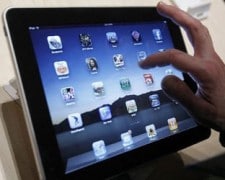 Findings from a top ten market study reveal that 32.7% of all Hispanics have logged on in the past month to an Internet radio website such as Pandora, iHeartRadio, Radio.com or Slacker.com. The figure represents 4.2 million Hispanic Internet radio listeners in The Media Audit’s top ten markets. Top ten markets for the Media Audit study include New York City, Los Angeles, Chicago, San Francisco, Dallas, Houston, Boston, Philadelphia, Washington, D.C. and Atlanta.
Findings from a top ten market study reveal that 32.7% of all Hispanics have logged on in the past month to an Internet radio website such as Pandora, iHeartRadio, Radio.com or Slacker.com. The figure represents 4.2 million Hispanic Internet radio listeners in The Media Audit’s top ten markets. Top ten markets for the Media Audit study include New York City, Los Angeles, Chicago, San Francisco, Dallas, Houston, Boston, Philadelphia, Washington, D.C. and Atlanta.
Among all adults in the same top ten markets, 22.8% reported having listened to Internet radio within the past week, making Hispanics 35% more likely to be listening to Internet radio when compared to the general population.
Among Hispanics in the top ten markets, 28.7% reported having logged on in the past month to Pandora Radio, while 8.4% logged on to iHeartRadio.com, and 1.9% logged on to Radio.com.
Additionally, 29.8% of Hispanics listened to Internet radio in the past week, suggesting nearly the same amount are logging on weekly as they are in a typical 30 day period.
While some terrestrial radio stations do better than others in terms of converting weekly listeners to loyal frequent listeners, it would appear that Internet radio is headed in a positive direction, says the report. With 91% of Hispanic monthly Internet radio visitors listening on a weekly basis, the preliminary data suggests that many Hispanics are becoming loyal to Internet radio listening.
The findings reflect the growing importance of this segment, as Hispanics now total 50.5 million or 16% of the total U.S. population who are of Hispanic or Latino descent, according to the most recent 2010 Census data. The data is also significant because Hispanic Internet radio listeners in those markets represent slightly more than half of the estimated 8.2 million total Hispanic Internet radio listeners across the 69 markets in which Internet radio data has been measured and reported.
The numbers show dramatic change in Hispanic Internet radio listening behavior from a year ago, when only 13.5% of Hispanics listened to Pandora Radio. As a result, the year over year growth rate is 142% for Hispanics accessing Pandora Radio. Furthermore, only 3.9% of Hispanics accessed iHeartRadio in 2011, resulting in a 182% increase in monthly visits year-over-year, while access to Radio.com increased 52% during the same period.
The study also found that among top Hispanic radio markets, Pandora and iHeartRadio remain competitive when compared to Hispanic-programmed local radio stations that heavily focus on the Hispanic market. In LA, 25.9% of the metro area’s 3.9 million Hispanics reported having listened to Pandora Radio within the past week, a figure that represents more than 1 million weekly listeners and topping weekly listening of all Hispanic-programmed stations or radio clusters.
In the NYC metro area, Pandora reaches 34% of the metro area’s 3.2 million Hispanics weekly, followed by 17.1% who listened to iHeartRadio within the past week. The weekly figures represent more than 1.1 million weekly listeners for Pandora, and 560,000 weekly listeners for iHeartRadio.
Among Miami’s 1.7 million Hispanics, nearly one in four listened to Pandora Radio within the past week, again ranking the service number one among all Hispanic-programmed stations or radio clusters.
Combined with the fact that more than half of Hispanic consumers are now accessing web content via a smart phone or a connected device such as an IPad, the findings suggest a narrowing digital divide between Hispanics and Caucasian consumers, thus making them more attractive to mobile and digital marketers. According to Pandora Radio, more than 75% of Pandora’s listening occurs on a mobile or other connected device.
It is estimated that by 2050, the number of Hispanics in the U.S. will grow to 132.8 million, strengthening the group’s collective purchasing power which is estimated to reach $1.4 trillion in 2013.
According to The Media Audit, areas in which Hispanics will have a strong economic impact include groceries, automotive, furniture, and clothing. Findings:
–One in four U.S. consumers planning to buy a home in the next two years are Hispanic
–19.2% of all U.S. consumers planning to buy a new or used vehicle in the next 12 months are Hispanic
–Nearly half of all Hispanics spend $150 or more per week on groceries, a figure that is 18% higher when compared to the general population
As a result of typically having larger families, Hispanics in the U.S. are 34% more –likely than the general population to frequently purchase children’s clothing
21% of Hispanics plan to buy furniture within the next 12 months, while 19.4% plan to remodel their home.




